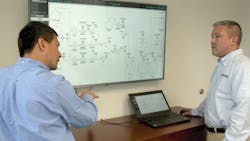Build your dream system on a flexible platform
With today’s technologies, it’s easier than ever to build your dream system. Organizations that implement versatile industrial-application platforms are giving themselves the opportunity to do things they weren’t able to do before. More and more entities are embracing modern application platforms and technologies, allowing themselves to create innovative industrial systems across numerous industries.
Supervisory control and data acquisition (SCADA) can be a strong foundation for digital transformation projects. A flexible, scalable SCADA platform enables connectivity to multiple sources of data, edge computing, MQTT, the cloud, mobility and more. While the following examples are from three different process industries, all of these projects were built on the same SCADA platform. With this open, interoperable, standards-based approach, numerous technologies can be combined for innovative solutions to fit any need.
From edge to cloud in record time
System integrator Industrial Networking Solutions (INS) helped ARB Midstream put up a new SCADA system, network and control center in just six months. The extremely tight timeline was dictated by the purchase agreement when ARB acquired a large pipeline system in Texas and Oklahoma. The system had 37 sites, including 25 truck injection stations and eight truck terminals. It included more than 900 miles of active pipeline and 950,000 barrels of storage. The previous SCADA system had issues with remote connectivity, which had to be solved in addition to the challenge of the aggressive schedule.
“We needed to build a SCADA system in six months,” said Jerod Blocker, operational technology manager for ARB. “We were able to accomplish that using a blend of different, newer technologies — executing on cloud computing, software-defined WAN and edge computing.”
Mo Moore, manager of software services at INS, said the project brought together a blend of technologies that could benefit other projects as well. “The diverse technologies that were implemented as part of this project — from the SD-WAN, to edge products using MQTT, to SCADA in the cloud — really are the gold standard for companies running remote assets or even plant-to-plant technologies in manufacturing,” said Moore. “It’s really where people should be going in the future.”
The project used Ignition for SCADA, Amazon Web Services for cloud hosting, Moxa industrial computers, Ignition Edge with Cirrus Link MQTT and Cradlepoint NetCloud Perimeter SD-WAN. INS created an abstracted overlay network built on cellular technology. That allowed ARB to have fully secure and encrypted end-to-end communications between remote assets and the cloud.
“We implemented user-defined types and templates to really make the graphical development and tag-structure rollout a much more efficient process,” said Moore. “Without having those capabilities built into the SCADA software, there’s no way we could have made the tight timeline.”
MQTT’s speed and low-bandwidth usage were a big help, too. Ninety-seven edge gateways communicated to 145 devices, moving polling to the edge of the network. All data was reported by exception to a central server using MQTT, reducing the bandwidth needed and providing access to more data at faster rates.
The project allowed ARB to easily deploy items to numerous disparate remote assets. Other benefits included a cloud-hosted solution that keeps CapEx costs down, store-and-forward, and the web-based SCADA system that lets managers help with troubleshooting from any location. ARB now has a secure, reliable, scalable network that will allow it to grow and acquire more remote assets.
Edge and MQTT for autonomous operation at remote sites
Streamline Innovations used Ignition’s SCADA, MQTT, edge computing and mobile capabilities to facilitate the automation of natural gas treating units that convert extremely toxic hydrogen sulfide (H2S) into fertilizer-grade sulfur. The solution increased uptime, reduced costs and provided access to much more data than Streamline had seen previously.
The chemical technology for H2S removal had been tried commercially before, but it hadn’t been profitable due to operational difficulties. Streamline created the new solution with updated chemistry, modern surfactant additives and a robust control and automation system. The new system is in use at numerous sites.
“With this SCADA system, we’ve been able to reduce the number of man-hours for our systems to just a few hours a week, yet still maintain over 99% uptime,” said Peter Photos, executive vice president of engineering for Streamline. “We didn’t think this was possible using current technology, but this off-the-shelf technology was able to facilitate our ability to do this.”
Streamline put in edge computing for complex calculations at the edge, making remote locations more autonomous and requiring much less human involvement. Streamline’s first approach employed an automation platform written on a standard PLC, but this didn’t enable complex calculations to provide model-based controls (and therefore semi-autonomous operation), nor remote control of the unit should a problem arise. Streamline turned to edge computing to run a number of Python scripts that allow complex calculations — such as fast Fourier transforms on pump vibration and weather forecasts downloaded from the National Weather Service to determine optimal operating temperature — something that wouldn’t be possible with a PLC. For some of its units, Streamline eliminated the PLC entirely, instead using edge computing and MQTT for getting data back to a cloud server.
“Because many of our units operate in remote locations, we needed to find a solution that allowed us to remotely control and operate these units, and also transmit the data over very weak-bandwidth areas,” said Photos. “MQTT offered a great solution, in which we were able to transmit and communicate data back to our servers and offer full bidirectional control, powered by the SCADA system.”
The edge computing saves time and money. Mobile capabilities within the SCADA system allow engineers to diagnose problems in the field more quickly. The mobile app also has all historian data and provides full bidirectional control. The system also provides data analytics, connection to the lab, reporting capabilities, trending and the ability to customize screens. Operators make customizations that help them run their own unique facilities. Tablet HMIs provide easier troubleshooting. Streamline is excited to be rolling this solution out to many more units in the near future.
Entire brewing process on a single software platform
MadTree Brewing Company of Cincinnati, Ohio, has seen rapid growth since it opened in 2013. As part of a $20 million expansion, it moved into its current home in 2017. MadTree also moved to a new SCADA platform that allowed it to create its own, unique brewing process. The entire process is on one platform, which includes the brewhouse, recipe management, cellaring, utilities, packaging and lab.
When seeking a new system for SCADA/HMI, MadTree didn’t want one that told it how to make its beer. It wanted a system that was flexible enough to let it do its own thing. Thus, it chose the Ignition software platform. “We really wanted the ability to monitor all aspects of production,” said Ryan Blevins, head brewer for MadTree. “This software really helped us with this. To be able to monitor utilities, packaging, brewhouse and even quality-lab data all in one place has been super-convenient. It helps us brew the best beer possible.”
The system integrator for the project was ThermalTech Engineering of Cincinnati. “I’ve worked with a lot of breweries in the past,” said Kyle Lehman, controls engineer at ThermalTech. “MadTree has a different approach. They want to analyze their data, make decisions off of it and then improve their processes based on that data.” He also noted that MadTree does more SCADA customization than most breweries.
The SCADA software connects to 70,000 process tags, 15 process PLCs on the plant floor, 150 process valves and about 50 sensors. The software gives brewers a clearer picture of their processes. “We’re getting data that we never had before,” said Blevins.
Stronger data analysis enables faster decision-making and better responses to issues. Remote access enables troubleshooting from anywhere. The software’s unlimited licensing enables MadTree to create as many projects as it wants. And there is now greater data-sharing within the company.
Previously, MadTree had many manual processes, with much of its data residing on paper. “This has been a great upgrade for us, as far as data collection and tracking,” said Blevins. “Before, we were using whiteboards and spreadsheets, and we had data all over the place. Now it’s in one convenient location.”
New SCADA brings speed plus 21 CFR 11 compliance
Snapdragon Chemistry is a leader in developing continuous-flow chemistry solutions for the discovery and production of active pharmaceutical ingredients, intermediates and materials. The company is based just outside Boston, and its customers discover and manufacture pharmaceuticals, animal care products, materials and other fine chemicals.
Snapdragon recently adopted a new Ignition SCADA system, and is leveraging it to help its customers comply with requirements from the United States Food & Drug Administration’s Title 21 of the Code of Federal Regulations Part 11 (21 CFR 11), which establishes rules for the use of electronic records and signatures, covering confidentiality, integrity, authentication and more.
The SCADA platform is aligned with the 21 CFR 11 requirements in terms of audit log, Active Directory security support and reporting. It also gives Snapdragon full control, trending, alarm management, access to more data than ever before and the ability to interface with numerous other systems. For development of drugs, the solution allowed the company to shrink timelines from years to a few months.
“We chose this SCADA system because it allowed us to meet the requirements in 21 CFR 11 while also providing a great deal of flexibility,” said David Ford, director of chemistry at Snapdragon. “As we work with our customers to design these systems to meet their requirements, our customers are very impressed with the flexibility we offer them — both in terms of changing the software, and in terms of the integration with their existing plant systems.”
The platform helps Snapdragon turn cutting-edge laboratory technologies into manufacturing technologies very quickly. “In clinical trials, speed is critically important,” said Matt Bio, president and CEO of Snapdragon. “And molecules may change quite often during clinical trials, so flexibility is very important. This platform provides us that ease of application, moving into the process development phase really quickly, and also the flexibility to be able to design our processes really quickly. So, it really helps our clients.”
System integrator NeoMatrix created the application for the project. It provides Snapdragon with the compliance features, full control, audit log, reports, trending, alarm management and security management. “We gave Snapdragon the ability to view trend history and access to all of the process data, and we also provided the ability to view all events,” said Danny Haskell, chief operating officer of NeoMatrix. “And we used the reporting capabilities to create batch reports — an official record that the customer can use as needed.”
Because it’s so flexible, NeoMatrix has used the software in a variety of industries. For Snapdragon, the SCADA system provides a clean interface for very complex machines. It also integrates with a lot of other technologies, something that’s a big help for Snapdragon. “It gives us the flexibility to build one control system that we can use across a range of projects and also in a range of manufacturing facilities,” said Ford.
Versatility is key
With technology evolving so quickly, it’s vital for organizations to take a modular approach. Build what you need today, but make sure it’s scalable for the future. A versatile platform for industrial applications will give you unlimited options — and fortunately for all of us, the technologies are here today.
Travis Cox is co-director of sales engineering at Inductive Automation, creator of the Ignition industrial application platform for SCADA, HMI, MES and the IIoT.





